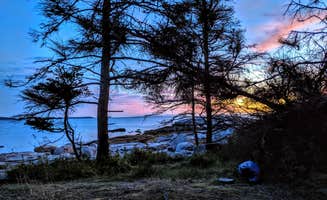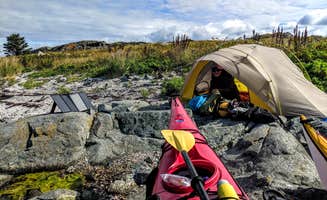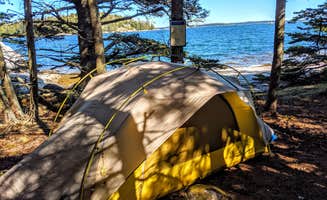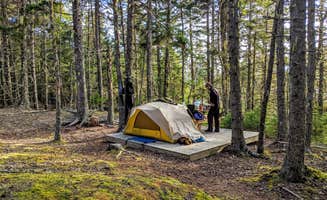The Deer Isle Archipelago off Maine's coast offers boat-in camping opportunities accessible only by water. Visitors navigate the Atlantic waters to reach these island sites which experience significant tidal ranges often exceeding 10 feet. The four islands operated by the Maine Island Trail Association (MITA) require careful navigation planning and self-sufficient wilderness camping skills.
What to do
Explore neighboring islands: Marshall Island features 985 acres of conserved wilderness with 7 miles of trails through spruce forests and past rocky shores. A paddle around the entire island takes approximately 4-5 hours depending on conditions. "Sand Cove is perfect for a beach fire and stargazing on a clear night– some of the best stargazing spots we've ever seen!" notes a visitor to Marshall Island.
Cross Jericho Bay: From Doliver Island, experienced kayakers can make the 4.5-mile crossing to larger islands. "Doliver Island is small with barely a tent space, but a good stop for us on our 9 day journey and a perfect launching spot for crossing Jericho Bay to Marshall Island the next day," reports one paddler who stayed at Doliver Island.
Visit Isle au Haut: Wheat Island serves as a base to explore the remote section of Acadia National Park on nearby Isle au Haut. "We stayed at the larger site and had a gorgeous view of the sun setting and full moon rising. Perfect island for exploring the close-by Isle au Haut, a remote section of Acadia National Park," according to a camper at Wheat Island.
What campers like
Sunset views: The western-facing campsites provide prime sunset viewing opportunities. "We stayed at the site by the shore and had a gorgeous view of the sun setting," writes a camper about Buckle Island, which offers two distinct camping areas with different perspectives.
Stargazing opportunities: The minimal light pollution creates exceptional night sky viewing conditions. Marshall Island campers report "some of the best stargazing spots we've ever seen" from Sand Cove beach, where open sky views allow for complete celestial panoramas.
Shell collecting: Doliver Island features a shell-covered beach with marine treasures. "Gorgeous shell covered beach and a beautiful view of Isle au Haut, just next door," notes a visitor who found the tiny island worthwhile despite its limited camping space.
What you should know
Tide planning: Landing can be challenging during high tide periods on several islands. "This can be a tricky island to land on at high tide, so plan accordingly," warns a visitor about Wheat Island, emphasizing the importance of consulting tide charts before arrival.
Insect preparation: Mosquitoes can be persistent even in September. "Be prepared for mosquitoes. We thought we were passed mosquito season in early September, but alas, they were pretty bad at sunset," reports a camper who visited Wheat Island.
Landing conditions vary: Some islands offer easier approaches for less experienced paddlers. "This is a perfect island for those new to sea kayak camping as the sandy shore, which is exposed for a good portion of the day, is easy to land on and a short walk to a trail into the woods," notes a review of Buckle Island.
Tips for camping with families
Choose larger sites: Marshall Island provides more space for group camping. "We stayed at one of the 2 sites near Sand Cove which is a truly gorgeous wooded area with a tent platform and a picnic table at each site," notes a camper who found the facilities suitable for small groups.
Emergency resupply options: For longer stays, know where to obtain necessities if needed. "If you happen to need a food or water resupply, Swan's Island is a short paddle away and has a very small grocery store and town office with fresh water," advises a Marshall Island visitor.
Space limitations: Some islands accommodate only minimal camping setups. Doliver Island has space that is "small with barely a tent space," according to one visitor to this free camping spot near Vinalhaven, Maine.
Tips from RVers
Staging locations: Leave vehicles at designated boat launches on the mainland. Old Quarry Campground in Stonington serves as a common starting point for paddling to these islands, with secure parking available for a fee.
Equipment transport: Pack ultralight camping gear designed for small watercraft. The limited landing and camping space on islands like Doliver requires minimal equipment that can be easily carried from shore to campsite.
Required permits: While dispersed camping on these islands is free for MITA members, non-members must obtain permission before landing. MITA membership provides access to more than 200 sites along the Maine Island Trail for no additional fee beyond annual membership.





